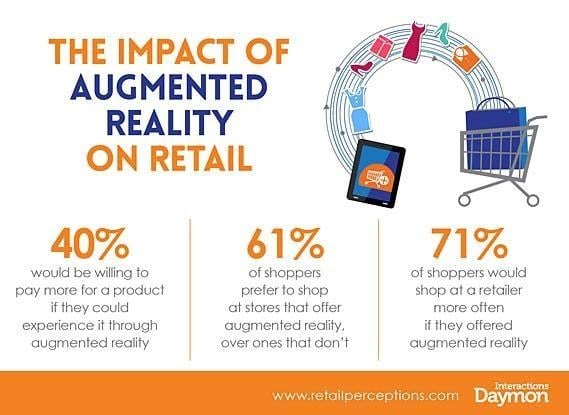The use of augmented reality (AR) in the retail space has already become too popular to deliver an engaging shopping experience. The promise of immersive experience apart, Augmented Reality (AR) continues to ensure real-time interactions between real-life and digital presentations.
Augmented reality (AR) closes the gap between physical shopping and digital shopping experiences. During the pandemic led scenario all through the 2020s, online and mobile shopping was the only means for digital interactions.
As per the Global Consumer Insights survey report of the PWC, the in-store shopping experience was largely replaced by online and mobile shopping. While digital shopping channels continued to grow in popularity for many years, the pandemic led scenario particularly brought mobile commerce to the forefront.
According to the report, mobile shopping has experienced a whopping 45% increase besides simultaneous increase in shopping through PCs, laptops and tablets.

As rightly pointed out by the report, the pandemic led crisis and lockdown measures came as disruption to the traditional retail and mobile interactions played the central role in keeping retail businesses operational and serving millions of customers with essential commodities.
Another report from the Office for National Statistics (ONS) in Great Britain recorded that February this year experienced the highest sales in comparison to the traditional sales channels. When the figure is compared with the online sales before the pandemic, there is a considerable increase.
We all know that AR has emerged as an era-defining technology for the retail space and has already paved the way for the most immersive and engaging shopping experience. Whether in physical stores or online stores, AR has delivered a seismic level of changes to transform the shopping experience. Today when you hire app developers for building innovative mobile apps for mobile commerce, AR is likely to be high above on the list of chosen technologies.
Here we are going to explain how AR technology can transform mobile e-commerce apps in terms of a more sophisticated shopping experience and business conversion.
Types of AR Applications

Augmented Reality (AR) technology can be applied in several ways. AR-based on the varying capabilities can be categorised into a few different types. If you want to know how much it costs to make an app with AR capability, you need to know about these AR types first.
Here we explain four different types of AR technologies.
Marker-based AR
Marker-based AR is also known as AR-based on Image Recognition or recognition-based AR. The core capability of this AR technology rests in the detection of the object or marker with the device camera and providing detailed information about the object. The details can be an alteration of the object into a 3D object or different layers of information or data to experience the product with intricate attributes. In a retail store you can capture the image of a product and through an AR-powered app of the retail store can have a 3-dimensional view of the object with minute details.
Markerless AR
Markerless AR is not about detecting particular objects in the real world atmosphere. In place of real-world objects, this type of AR technology detects the virtual object in a real-world environment. The AR games like Pokemon Go are a great example of this type of AR that needs players to detect Pokemons in a real-world environment by utilising the AR game app.
Location-based AR
Location-based AR is a subset of markerless AR technology and it uses the particular geographic location of the object to show digital content at various locations. Again, Pokemon Go is a superb example of this type of AR technology.
Projection-based AR
Projection-based AR is all about creating special effects or filtered effects on physical objects and surfaces and partially allowing other users to interact with such objects and surfaces. The cinematic holograms used in certain movies like Star Wars and social media filters are great examples of this AR technology.
How can AR revolutionise mobile commerce?
The biggest value proposition of Augmented Reality (AR) technology is the sophisticated and immersive experience blurring physical reality and digital reality. In the context of e-commerce and mobile commerce stores, AR particularly shows many promises such as the digital trial of products before purchase, personalised shopping experience, interactive user manuals and satisfactory and more informed shopping experience resulting in fewer returns and cart abandonment instances.
Customers are capable to before purchase
Today most car dealers and automobile brands through their websites allow customers to have a 360-degree view or a virtual reality visual tour of the car models to make sure that customers always have a real-life experience of the vehicle they are deciding to buy. Augmented Reality by going one step further can even allow customers to compare the car size and dimension with the space available in a parking lot or garage.
Customers always want to try products before they decide to buy. AR technology has emerged as a great tool to offer customers this scope of the digital trial. Thanks to AR, customers now can see a product with minute details before adding them to the cart.
The mobile commerce store of the furniture brand IKEA provides a nice example of this virtual trial feature. Through IKEA Place, the AR-based app of the brand, you can just upload your room image and see how the furniture looks in your room settings with every detail automatically taken care of by the app.
Similarly, we now have AR apps for trying makeup or cosmetic products on your body and skin and see on a mobile screen whether it suits you or not. Similar apps in the future will be showing how you look in a particular t-shirt or shorts. The uncertainty involved in making online purchases can be completely removed by AR-powered virtual trials.
Personalized shopping experience

Augmented Reality in the context of mobile commerce ensures a lot of granular level interactions that are likely to improve the shopping experience with great delights for customers who are buying the items.
AR simply by offering more controls and autonomy to the mobile commerce customers creates space for establishing a brand connection with more certainty. With a quick finger, taps on the screen customers can tweak the colours, styles and try virtual trials on their appearance and can take a call on the purchases.
Interactive user manuals
Some products involve a considerable learning curve for the customers who are going to purchase and use them. For example, often a high-value camera with too deep manual controls can prove to be challenging for a new user to handle. AR-powered interactive user manuals for such products can be a real help for users.
With an interactive user manual that stays in sync with user actions and offers context-aware support to the users, it becomes very easy to scan any product and get hands-on learning about the buttons, controls and intricacies of different settings.
Social media filters
Social media filters are a common feature for Instagram Stories or Snapchat. These social channels by using AR filters can help users to see how different effects change their appearance.
These filters also bring a fun element to the images and boost audience engagement. An e-commerce brand by utilising these filters can boast of a trendy look and feel and can make a distinct and unique brand appearance.
Reducing product returns

A great volume of mobile commerce profits is taken away by the product returns following unsatisfactory or less-informed purchases. This is where AR-powered virtual trial or personalised shopping experience can play a vital role to reduce the product return instances to a minimum level.
Since AR is helping mobile commerce customers to try products well before reaching a purchase decision, customers are very unlikely to purchase several items and return most of them after trying in their homes. This will ensure the number of confirmed sales, reduce delivery and other expenses and increase profitability to the maximum.
Conclusion
Augmented Reality (AR) technology is now very much part and parcel of mobile commerce and in the years to come it will play a more influential role in improving the e-commerce shopping experience and improving business conversion.



![[Research Round-Up] New Study Shows the Continuing Value of B2B Thought Leadership](https://customerthink.com/wp-content/uploads/development-2010010_1280-pixabay-innovation-ideas-think-1-218x150.jpg)